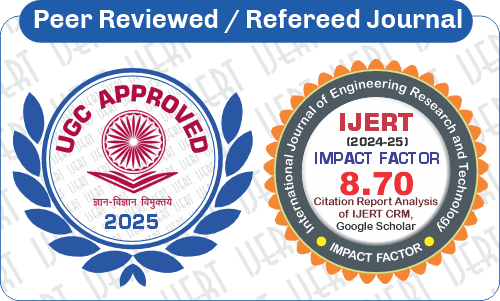 DOI : 10.17577/IJERTV6IS040726
DOI : 10.17577/IJERTV6IS040726
- Open Access

- Total Downloads : 91
- Authors : Pranjal S. Watharkar, Dr. A. C. Attar
- Paper ID : IJERTV6IS040726
- Volume & Issue : Volume 06, Issue 04 (April 2017)
- DOI : http://dx.doi.org/10.17577/IJERTV6IS040726
- Published (First Online): 29-04-2017
- ISSN (Online) : 2278-0181
- Publisher Name : IJERT
- License:
 This work is licensed under a Creative Commons Attribution 4.0 International License
This work is licensed under a Creative Commons Attribution 4.0 International License
Traffic Management for Urun-Islampur City
Pranjal S Watharkar
Dep of Civil Engineering, Rajarambapu Institute of Technology Rajaramnagar
Dr. A. C. Attar
Dep of Civil Engineering, Rajarambapu Institute of Technology Rajaramnagar
Abstract Traffic Data Collection and projections there of traffic volumes are basic requirements for planning of road development and management schemes. Traffic Data forms an integral part in the science of descriptive national economics and such knowledge is essential in drawing up a rational transport policy for movement of passengers and goods by both government and the private sectors. In this paper the requirements for developing traffic control model for Urun- Islampur city are shown. This paper shows manual counting method. The data collected manually as per requirements. Data collection method is helpful for collecting Traffic Data in any city.
-
INTRODUCTION
Indian traffic characteristics are fundamentally very different from those in the developed countries. India with heterogeneous type of traffic needs speed flow-curve to be defined according to road and traffic conditions prevalent in Indian condition. Urun-Islampur is one of the fast developing Indian city in the District Sangli, State Maharashtra. Also Urun-Islampur is the main city in Walwa tahsil. The city is surrounded by minor and major industries and has also become an educational hub. Due to this reason the vehicles are rapidly growing in this city and creates lots of traffic congestion problems.
Parking system is one of the essential parameter for traffic management for Urun-Islampur. In Urun-Islampur city no parking space is available and none of any traffic signal is present. This is the main reason creates traffic congestion. Also heavy vehicles creates congestion and traffic jam problem. For the directing the vehicles signals and sign boards are necessary but there is no one facility available for directing vehicles.
For the reducing traffic congestion Urun-Islampur municipal takes initiative for traffic management. The Proper traffic management reduce congestion and directing vehicles smoothly. Urun-Islampur municipal needs to flow of traffic should be smooth and the vehicles are directed easily. Urun- Islampur municipal needs to develop a plan for well traffic management
A. Congestion and Definition
Congestion is a condition in which the number of vehicles attempting to use a roadway at any time exceeds the ability of the roadway to carry the load at generally acceptable service levels. Because of huge crowd and unconditional roads creates traffic congestion problems. The proper traffic management is necessary to remove traffic congestion. Traffic congestion increases because of peak period traffic growth
-
SCOPE OF THE STUDY
The study divides the urun islampur city in 9 broad zones. All city roads are considered for the study. Data collected for traffic volume count, accidents survey for safety purpose, parking facilities, calculation of traffic speed, average growth of vehicles and for bus stop management.
-
METHODOLOGY
-
Identificatin of study links
-
Data Collection
-
Data collect from congested area by manual counting method
-
Data collect from bus depot
-
Accidental data
-
Major accidents
-
Minor accidents
-
-
Parking data in peak hours
-
Time analysis
-
Vehicle growth data
-
-
Conclusion
-
-
TURNING MOVEMENT SURVEY OF VEHICLES AT SELECTED ZONES
12 hours Manual Traffic Counts have been conducted to cover all the Vehicular Movements at the congested area. The Turning Movement Survey has been conducted to obtain Information on Mode wise and Direction wise Turning Movement of Traffic at the Intersection. The Survey has been conducted for 12 hours (8:00am to 8:00pm) covering morning and evening peak hours. Traffic Counting has been carried out manually by using hand tally. The Count Data have been recorded per hour for each vehicle category has been computed. The Traffic Volume Count Data has been processed using the commonly used Spreadsheet Package. The processed Hourly Traffic Volume Data has been compiled Direction wise. The Peak Hourly Directional Vehicular Movement Data has been used to plan and design the Improvement Scheme such as Grade Separation and At Grade Intersections
Motorized Traffic
Non-Motorized
Traffic
2-Wheelers, Auto Rickshaw, Passenger Car ,
Car, Taxi and jeep
Bicycle, Cycle, Animal Drawn
Vehicle, Hand
Utility Vehicle : Van and Tempo
TABLE I. TYPE OF VEHICLES
Bus
Mini Bus
Standard Bus
Drawn Cart
Truck
Light Commercial
Vehicle (LCV)
Heavy Commercial
Vehicle (HCV)
Farm Vehicles
Agricultural Tractor
(AgT)
Agricultural Tractor &
Trailer (AgTT)
VI. TRAFFIC VOLUME COUNT
Traffic volume count is carried out in Nov Dec 2016is given below. The identification of peak hour was done by traffic volume study in 12 hours 8am to 8pm working day study. The peak hours were identified at 9.30am to 12pm and 5.30pm to 7.30pm. Evening peak was more congested than morning seen by observation and collected data
TABLE III. TOTAL VEHICLES IN DAY
Vehicle
s
Places
Motorc
ycle
Jeep/
Car
Auto
Rickshaw
Truck/
Bus/ Temp o
Lorry
Tracto
r
Others
Gandhi
Chouk
16997
595
610
15
0
4
2
Yallama
Chouk
15992
272
415
164
2
9
11
Asta
Naka
22493
7561
1425
3357
412
468
359
Zari
Naka
24957
8556
3992
3402
469
276
31
Azad
chouk
15332
407
532
65
0
7
1
Bahe
Naka
12875
342
277
355
4
85
67
Jayant Patil
Chouk
23341
6963
2004
2706
346
361
113
Ambedk
ar Naka
9410
6381
746
3739
670
668
552
Juni Bhaji
Mandai
12332
314
558
44
0
3
9
-
ANALYSIS OF TURNING MOVEMENT COUNT DATA
Trafic data have been assembled on hourly basis to determine the most appropriate Peak Hours. Data collected from Traffic Surveys have been computerized and analyzed to study Hourly Variation of Traffic, Peak Hour Flows, and Traffic Composition etc. The Counts have been classified by Category of Vehicles and by Direction of Movement. The various Vehicle Types having different Sizes and Characteristics have been converted into Equivalent Passenger Car Units. The Passenger Car Unit (PCU) Factors recommended by Indian Road Congress in Guidelines for Capacity of Urban Roads in Plain Areas (IRC: 106 1990) have been used
Sr .No
Vehicle Type
Equivalent PCU Factor
% composition of Vehicle Type
Up to 10%
10% and
above
A
Fast Vehicles
1
Two wheeler, Motorcycle
0.5
0.75
2
Passenger car, pick up van
1.0
1..0
3
Auto Rickshaw
1.2
2.0
4
Light Commercial vehicle
1.4
2.0
5
Truck or Bus
2.2
3.7
6
Agricultural tractor trailer
4.0
5.0
B
Slow Vehicles
1
Cycle
0.4
0.5
2
Cycle Rickshaw
1.5
2.0
3
Horse drawn vehicle
1.5
2.0
4
Hand cart
2.0
3.0
TABLE II. PCU FACTOR OF VEHICLES
-
DATA COLLECTED FROM BUS DEPOT
The buses are creates more traffic congestion problem in city. This data is collected from urun islampur bus depot for directing buses in proper time management to reduce traffic congestion problem. The collected data is useful for the bus stop management.
TABLE IV. BUS DATA
Monday to Saturday
Sunday
Gandhi Chouk
0
0
Yallama Chouk
14
7
Asta Naka
374
335
Zari Naka
466
417
Azad chouk
0
0
Bahe Naka
31
30
Jayant Patil Chouk
378
356
Ambedkar Naka
229
209
Juni Bhaji Mandai
0
0
-
ACCIDENTAL DATA
The main purpose of collecting accidental data is safety. The data was collected from urun islampur police station records. The data was collected from year 2012 to 2016 by police records. The data is divided in two forms Major accidents and Minor accidents.
TABLE V. MAJOR ACCIDENTS
Year
Accidents
2012
4
2013
3
2014
6
2015
6
2016
6
TABLE VI. MINOR ACCIDENTS
Year
Accidents
2012
15
2013
12
2014
9
2015
5
2016
3
-
PARKING DATA
Parking data consist of type of vehicles (two wheeler, four wheeler, hand cart, rickshaw,tempo and tractors) and number of vehicles for selected route. The data is collected for well parking management and to provide road parking space. This data is collected by manual counting in peak hours. Also the available parking space data collected from urun islampur municipal
TABLE VII. NUMBER OF VEHICLES PARKED IN SELECTED ROUTE
Route
Number of vehicles parked 5pm to 7pm
Number of vehicles parked
9am to 11am
Bahe naka to
yallama chouk
250
134
Yallama chouk to
gandhi chouk
102
83
Gandhi chouk to
azad chouk
166
114
Azad chouk to zari
naka
290
58
Juni bhaji mandai to
shani mandir
349
290
Asta naka to
ambedkar naka
42
30
Jain mandir road
34
23
Jayant patil chouk to
juni bhaji mandai
146
180
Jayant patil chouk to
zari naka
291
236
Zari naka to asta
naka
111
137
Market yard road
44
91
TABLE VIII. AVAILABLE PARKING SPACE
-
TIME ANALYSIS
In time analysis, traveling time for selected route is find out. For finding this traveling time manual method is used in this method motor cycle passion plus is used. Following tables shows time analysis for different route from 6pm to 8pm and 9am to 12am respectively.speed breakers breaks the speed and delay the time for that number of speed breakers also calculated
TABLE IX. TIME ANALYSIS (9AM TO 11AM)
Route
Time
Speed
breakers
Distance
Yallama chouk To Gandhi
chouk
22509
3
0.2km
Gandhi chouk To Azad
chouk
013407
6
0.3km
Azad chouk To Zari naka
020705
5
0.4km
Zari naka To Jayant patil
chouk
021808
0
0.6km
Zari naka To Asta naka
013408
0
0.8km
Asta naka To Ambedkar
naka
013502
0
0.5km
Asta naka To Bahe naka
031507
1
0.9km
Bahe naka To Gandhi
chouk
021800
5
0.6km
Bahe naka To Yallama
chouk
012303
3
0.4km
Gandhi chouk To Juni
bhaji mandai
011702
3
0.3km
Juni bhaji mandai To Azad
chouk
005305
4
0.2km
Jayant patil chouk To Juni
bhaji mandai
023007
3
0.8km
Jayant patil chouk To
Azad chouk
022701
7
0.7km
Route
Time
Speed
breakers
Distance
Yallama chouk To
Gandhi chouk
004709
3
0.2km
Gandhi chouk To
Azad chouk
012809
6
0.3km
Azad chouk To Zari
naka
014205
5
0.4km
Zari naka To Jayant
patil chouk
015406
0
0.6km
Zari naka To Asta
naka
015509
0
0.8km
Asta naka To
Ambedkar naka
011007
0
0.5km
Asta naka To Bahe
naka
030309
1
0.9km
Bahe naka To Gandhi
chouk
015103
5
0.6km
Bahe naka To
Yallama chouk
011006
3
0.4km
Gandhi chouk To Juni
bhaji mandai
010306
3
0.3km
Juni bhaji mandai To
Azad chouk
011100
4
0.2km
Jayant patil chouk To
Juni bhaji mandai
025506
3
0.8km
Jayant patil chouk To
Azad chouk
024109
7
0.7km
TABLE X. TIME ANALYSIS P(6PM TO 8PM)
Route
Parking space
Bahe naka to yallama chouk
704sqm
Yallama chouk to gandhi chouk
No parking space
Gandhi chouk to azad chouk
218sqm
Azad chouk to zari naka
484sqm
Juni bhaji mandai to shani mandir
484sqm
Asta naka to ambedkar naka
484.4sqm
Jain mandir road
No parking space
Jayant patil chouk to juni bhaji mandai
No parking space
Jayant patil chouk to zari naka
No parking space
Zari naka to asta naka
No parking space
Market yard road
No parking space
-
VEHICLE GROWTH DATA
The vehicle growth data was collected from RTO department Sangli. The rapidly vehicle growth creates congestion problem in city. The data was collected from year 2011 to 2016 by RTO records.
Year
Total Vehicles
2011
4,59,207
2012
5,20,901
2013
5,72,632
2014
6,27,352
2015
7,12,631
TABLE XI. VEHICLE GROWTH DATA
-
CONCLUSION
-
The collection of data by manual counting method is used for well traffic management. The manual counting method is easy to work and well observed meathod.The data used to create better traffic control model
REFERENCES
-
Angélica Lozano*, Francisco Granados, Alejandro Guzmán, Impacts of modifications on urban road infrastructure and traffic management: a case study,(ASCE)MT.28(06):04016006.
-
Tuba Kilavuza,*, Recep Kisla , Demand management methods for the environment oriented hybrid traffic system to be implemented in Istanbul, (ELSVIER) 6th Transport Research Arena April 18-21, 2016I.S. Jacobs and C.P. Bean, Fine particles, thin films and exchange anisotropy, in Magnetism, vol. III, G.T. Rado and H. Suhl, Eds. New York: Academic, 1963, pp. 271-350.
-
Felix K¨oster , Marlin W. Ulmer , Dirk C. Mattfeld Cooperative Traffic Control Management for City Logistic Routing,(ELSVIER)EWGT 2015, 14-16 July 2015R. Nicole, Title of paper with only first word capitalized, J. Name Stand. Abbrev., in press.
-
Partha Sarathi Chakrabortya*, Arti Tiwaria, Pranshu Raj Sinhab Adaptive and Optimized Emergency Vehicle Dispatching Algorithm for Intelligent Traffic Management System (ELSVIER) 2015 (ICRTC- 2015)
-
Filmon G. Habtemichael,, Mecit Cetin , Short-term traffic flow rate forecasting based on identifying similar traffic patterns"
-
Griselda López, Juan de Ona, Laura Garach, Leticia Baena), Influence of deficiencies in traffic control devices in crashes ontwo- lane rural roads", (ELSVIER) Accident Analysis and Prevention 96 (2016) 130139
-
Amit K. Savla _ E. Lovisari G. Como Maximally Stabilizing Tra_c Signal Control with Unknown Turn Ratios
-
Mohsin Manzoor Janwari*a, Geetam Tiwarib , Sudershan K. Poplic ,
M. S. Mird Traffic Analysis of Srinagar City dec 2014
-
IRC: 106-1994, Guidelines for Capacity of Urban Roads in Plain.
-
Kumar, B. P., K. K. Rao, 2011. Defining level of service criteria of urban streets in Indian context, European Transport




